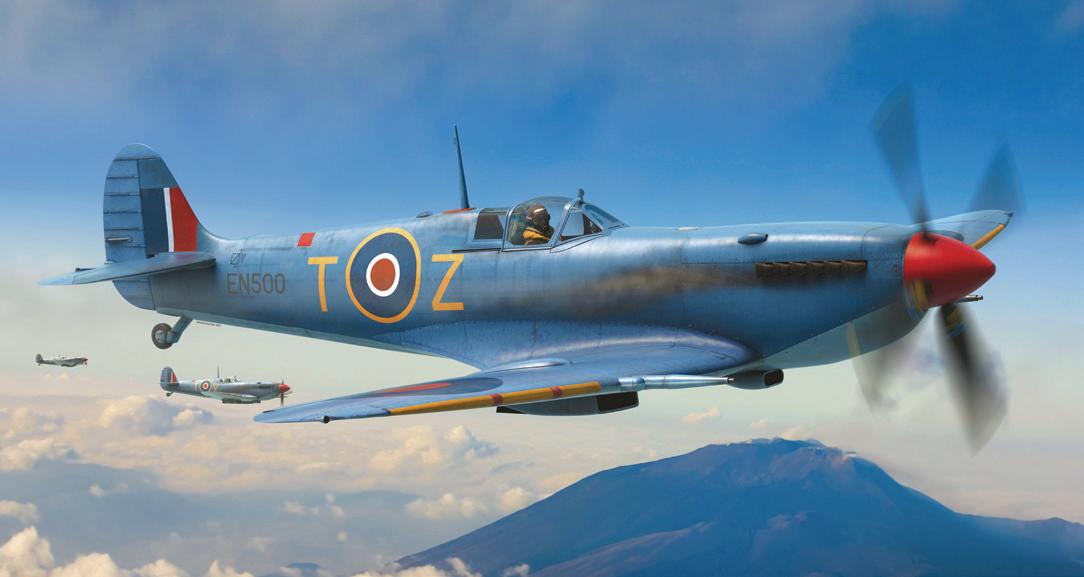Spitfire F Mk.IX
1/72 Scale Plastic Model Kit


The Supermarine Spitfire is so iconic, that virtually everyone can recognize it. The service of this elegant fighter spanned remarkable thirteen years. It entered into service at the end of biplane era and remained on frontline duty until the jet age.
By the early 30s the RAF was looking for replacement of its ageing Hawker Fury biplane fighters. The need of considerably faster aircraft was obvious, as the racing monoplane floatplanes of that time reached about twice the speed of the Fury. One of the most successful designers of racing floatplanes was Reginald J. Mitchell. His Supermarine S.6B raised the world speed record to 407 mph (655 km/h) on 20 September 1931, and British Air Ministry, under influence of such achievement, issued the specification F.7/30 in October 1931. Although it called for modern pursuit airplanes capable of at least 250 mph (400 km/h), seven out of eight entries were biplanes. The only monoplane proposal was Mitchel´s Supermarine 224, but a gull wing design with fixed undercarriage and Rolls-Royce Goshawk engine was a disappointment. After that the RAF chose the Gloster Gladiator biplane as the winner.
Early work
The fiasco with Type 224 did not prevent Mitchell from further work. He persuaded the Supermarine company to fund the work on the completely new design Type 300 using the brand new Rolls-Royce PV12 engine, later known as the Merlin. The Air Ministry expressed interest and issued specification F.37/34 on 28 December 1934 to fund a prototype armed with four wing mounted guns. But by early April 1935 Mitchell received the detail of specification F10/35, calling for eight guns. The change was made on cost of bomb provision removal and reduction of the capacity of the fuel tanks to sixty-six gallons. The decision caused the so called “short legs” of the Spitfire, meaning a lack of range and endurance.
The Type 300 made its maiden flight on 5 March 1936, an initial contract to produce 310 Spitfires was signed in June 1936 and the first unit to receive the new fighter was No. 19 Squadron at Duxford in August 1938.
Catching the progress
The Spitfire’s development was an ongoing process and incorporated many changes. From the early Mk.I and Mk.II the development reached the pointwhere a more substantial step was required. The Mk.V was a result, but it was in fact a Mk.I powered by the more powerful Merlin 45 series engine. The Mk.V entered service from early 1941, helping the RAF to counteract the Bf 109’s development. But in September 1941, a hitherto unknown German radial engine fighter emerged and started to rule the European skies. The new Fw 190 was superior to British fighters, even to the Spitfire Mk.V. The losses suffered by the RAF over western Europe rose rapidly and the crisis was serious enough that the RAF ceased most daytime operations during November 1941. The next attempt to resume this type of sorties was made in March 1942. But losses remained unacceptably high, and the RAF was forced to stop offensive operations once again. All this was due to the supremacy of the Focke-Wulf Fw 190A. The first RAF response to the new situation was the Spitfire Mk.VIII, but the design changes were so complex that initiating timely production was not possible. In June 1942, a German pilot landed by mistake on a British airfield delivering a completely intact Fw 190A fighter into RAF hands.
Comparative trials between the Focke-Wulf and Spitfire Mk.V began almost immediately and confirmed the situation over the front – the chance of a Spitfire Mk.V to survive an encounter with the Fw 190s was rather poor. The only British fighter aircraft deemed suitable to oppose the German opponent were the Spitfires Mk.VII and Mk. VIII powered by the Merlin 61 engine. But as these marks required some time to get into production, another way of getting a powerful fighter as quickly as possible was sought for. And it was found in mating the two-stage supercharger Merlin 61 with the fuselage of the Spitfire Mk.Vc.
Saviour
Two Mk.Vc airframes, AB196 and AB197, were selected for the conversion and their fuselage was strengthened with modified longerons to accommodate the more powerful and heavier engine. The first example was finished on February 26 and the second on March 27, 1942. Trials were successful and the order for series production was issued almost immediately. Series production began in June 1942 and the first Mk.IXs found their way to No. 64 Squadron in July. Performance improved significantly in comparison to the Mk.V. The top speed of 409 mph (658 km/h) at 28,000 feet (8530 m) was higher by 40 mph (64,4 km/h), and the service ceiling rose from 36,200 ft (11,033 m) to 43,000 ft (13,106 m).
With the Mk.IX the RAF finally got a fighter capable to oppose the Fw 190A. Three main variants of the Mk.IX were produced. The F Mk.IX was powered by the Merlin 61 and was the only version on the assembly line in early 1943. The next was the LF Mk.IX powered by the Merlin 66. This engine was designed to do its best at low-to-medium attitude. The third version, manufactured along with the LF, was the high-altitude HF Mk.IX with the Merlin 70.
The majority of Mk.IXs manufactured were equipped with the so-called C-type wing. Four 20mm cannon or two 20mm cannon and four .303 in machine guns could be installed in the wings. From 1944, E-type wing was produced with four outer .303 in machine guns replaced with two .50 in heavy machine guns installed in the inner bays. Bomb racks for 250lb bombs were fitted under each wing.
The Mk.IX became the second most numerous mark of the Spitfire with a total of 5653 examples built. The Mk.IX began to replace the Mk.V from June 1942. Thanks to the new fighter, the RAF was ready to fight against the Luftwaffe over occupied Europe.
The Kit: Spitfire F Mk.IX
The F Mk.IX was the first of all the Mk.IX Spitfires, as the very first examples were in fact rebuilt Mk.Vs. These early aircraft retained many features of the predecessor, including the large blisters over the cannon bays. These were intended to accommodate two 20mm cannons each and some aircraft flew with this rather heavy armament. But most of them had the outer cannon bays empty with aerodynamical cover of the opening in the leading edge. There were also some examples with that opening completely removed.
INSTRUCTIONSIGNS
A38 B C14 A B38 step 2 step 1
FOR CLOSED CANOPYONLY
- 0,8 mm for ext. fuel tank (part B12)
UNDERSURFACE COLOR
B51 B35
UNDERSURFACE COLOR
B50
B48
UNDERSURFACE COLOR
B35
UNDERSURFACE COLOR G6
B46
COLOR
UNDERSURFACE COLOR
UNDERSURFACE COLOR UNDERSURFACE COLOR
UNDERSURFACE COLOR
decal 39 ? 40 ? 41 ? 42 (70120)
UNDERSURFACE COLOR
UNDERSURFACE COLOR
B C MARKINGS , D , ONLY
B C MARKINGS , D , ONLY



















